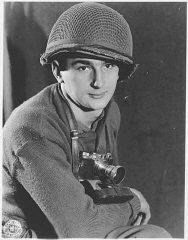
Photo
Browse an alphabetical list of photographs. These historical images portray people, places, and events before, during, and after World War II and the Holocaust.
<< Previous | Displaying results 1251-1275 of 2609 for "Photo" | Next >>
-
Insignia of the 84th Infantry Division
PhotoInsignia of the 84th Infantry Division. The 84th Infantry Division derives its nickname, "Railsplitter" division, from the divisional insignia, an ax splitting a rail. This design was created during World War I, when the division was known as the "Lincoln" division to represent the states that supplied soldiers for the division: Illinois, Indiana, and Kentucky. All figured prominently in the life of President Abraham Lincoln, of log-splitting legend.
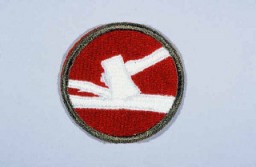
-
Insignia of the 86th Infantry Division
PhotoInsignia of the 86th Infantry Division. The 86th Infantry Division developed the blackhawk as its insignia during World War I, to honor the Native American warrior of that name who fought the US Army in Illinois and Wisconsin during the early nineteenth century. The nickname "The Blackhawks" or "Blackhawk" division is derived from the insignia.
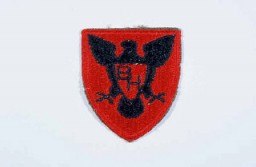
-
Insignia of the 89th Infantry Division
PhotoInsignia of the 89th Infantry Division. The 89th Infantry Division's nickname, the "Rolling W," is based on the division's insignia. Created during World War I, this insignia utilized a letter "M" inside a wheel. When the wheel turns, the "M" becomes a "W." The letters "MW" signify the mid-west origin of the troops who formed the 89th during World War I. The division was also known as the "Middle West" division, another variation on its origin.

-
Insignia of the 8th Armored Division
PhotoInsignia of the 8th Armored Division. The nickname of the 8th Armored Division, the "Thundering Herd," was coined before the division went to Europe in late 1944. It was also known as the "Iron Snake" late in the war, after a correspondent for Newsweek likened the 8th to a "great ironclad snake" as it crossed the Rhine River in late March 1945.
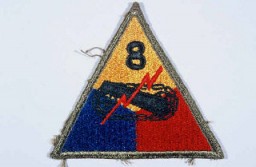
-
Insignia of the 8th Infantry Division
PhotoInsignia of the 8th Infantry Division. The 8th Infantry Division was known as both the "Golden Arrow" and "Pathfinder" division during World War II. Both nicknames originated from the division's insignia, which includes a gold arrow to represent the nineteenth century explorer of California, John Fremont. The division was formed in California in 1918.

-
Insignia of the 90th Infantry Division
PhotoInsignia of the 90th Infantry Division. Called the "Tough Ombres," the 90th Infantry Division was raised from draftees from the states of Texas and Oklahoma during World War I. The divisional insignia incorporates the letters "T" and "O" to symbolize both states. These letters later yielded the nickname "Tough Ombres," symbolizing the esprit de corps of the unit. The 90th was also sometimes called the "Alamo" division during World War II.

-
Insignia of the 95th Infantry Division
PhotoInsignia of the 95th Infantry Division. The 95th Infantry Division, the "Victory" division, gained its nickname from the divisional insignia approved in 1942: the arabic numeral "9" combined with the roman numeral "V" to represent "95." The "V" led to the nickname, since the letter "V" was universally recognized as an Allied symbol for resistance and victory over the Axis during World War II.
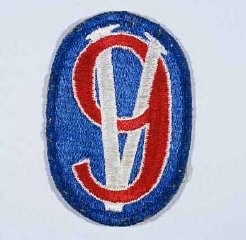
-
Insignia of the 99th Infantry Division
PhotoInsignia of the 99th Infantry Division. The 99th Infantry Division, the "Checkerboard" division, gained its nickname from the division's insignia. The insignia was devised upon the 99th's formation in 1942, when the division was headquartered in the city of Pittsburgh. The blue and white checkerboard in the division's insignia is taken from the coat of arms of William Pitt, for whom Pittsburgh is named. The division was also known as the "Battle Babies" during 1945, a sobriquet coined by a United Press…
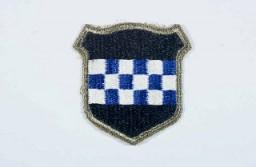
-
Insignia of the 9th Armored Division
PhotoInsignia of the 9th Armored Division. Although no nickname for the 9th was in common usage throughout World War II, "Phantom" division was sometimes used in 1945. It originated during the Battle of the Bulge, when the 9th Armored Division seemed, like a phantom, to be everywhere along the front.
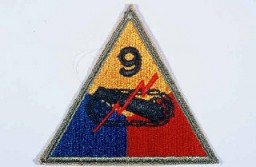
-
Instructions posted during Japanese American relocation
PhotoA notice posted on a wall in San Francisco, California, lists “evacuation” instructions for the area’s Japanese American residents, 1942. They were deported, first to temporary “assembly centers,” and from there to relocation centers in remote areas of the United States.
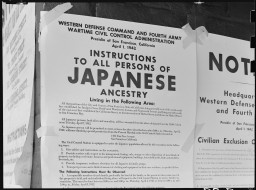
-
Internally displaced persons camp in Iraqi Kurdistan
PhotoAn elderly Yazidi woman tends to young children beside a half-constructed building in an internally displaced persons (IDP) camp where they live in Duhok, Iraqi Kurdistan. September 7, 2015.

-
Internally displaced persons (IDP) camp near Erbil, Iraqi Kurdistan
PhotoA Sunni man from Mosul, Iraq, prays as the sun sets over an internally displaced persons (IDP) camp near Erbil, Iraqi Kurdistan. September 2, 2015.
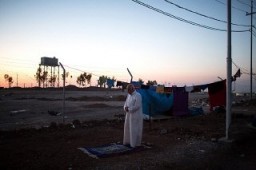
-
International Criminal Tribunal for Rwanda
PhotoOffices of the International Criminal Tribunal for Rwanda (ICTR) in Arusha, Tanzania.
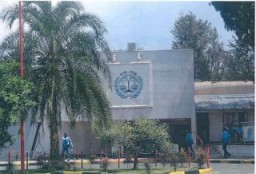
-
International Tracing Service boxes containing documentation about Gross-Rosen
PhotoInternational Tracing Service (ITS) boxes containing documentation about Gross-Rosen. The archive was established by the Allied powers after World War II to help reunite families separated during the war and to trace missing family members. Bad Arolsen, Germany. Learn more about the ITS.
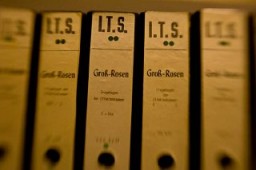
-
Internment camp for Roma (Gypsies)
PhotoRoll call at an internment camp for Roma (Gypsies). Lackenbach, Austria, 1940–41.
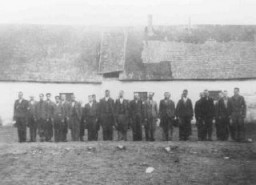
-
Interpreters at the International Military Tribunal
PhotoView of the interpreters' section in the courtroom during the International Military Tribunal. Nuremberg, Germany, March 29, 1946. The Nuremberg trials were an early experiment in simultaneous translation. The charter of the International Military Tribunal stated that the defendants had the right to a fair trial and that, accordingly, all proceedings be translated into a language that the defendants understood.

-
Invasion of Greece
PhotoSS troops advance during the invasion of Greece. The invasion of the Balkans began in April 1941. Greece, wartime.

-
Invasion of Yugoslavia
PhotoGerman Stuka dive-bombers fly over Yugoslavia during the German invasion of Yugoslavia, which began on April 6, 1941. Yugoslavia, ca. April 6, 1941.
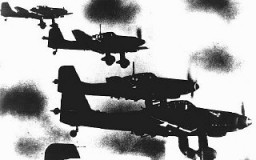
-
Investigating German atrocities
PhotoMembers of a US congressional committee investigating German atrocities view the emaciated body of a dead prisoner at the Dora-Mittelbau concentration camp, near Nordhausen. Germany, May 1, 1945.

-
Ion Antonescu before his execution
PhotoFormer Romanian prime minister Ion Antonescu (center) before his execution as a war criminal. Fort Jivava, near Bucharest, Romania, June 1, 1946.
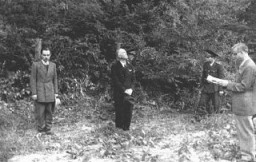
-
Portrait of Żegota member Irena Sendler
PhotoPortrait of Irena Sendler in Warsaw, Poland, circa 1939. Irena Sendler (1910–2008) was a member of the Council for Aid to Jews, codenamed “Żegota.” Żegota was a clandestine rescue organization of Poles and Jews in German-occupied Poland. Supported by the Polish government-in-exile, Żegota coordinated efforts to save Jews from Nazi persecution and murder. It operated from 1942 to 1945. Irena Sendler (Sendlerowa) was working as a social worker in Warsaw when World War II broke out in 1939. After…
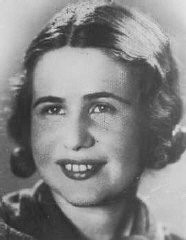
-
Irmgard Huber, chief nurse at Hadamar euthanasia killing center
PhotoPortrait of Irmgard Huber, chief nurse at the Hadamar euthanasia killing center, in her office. The photograph was taken by an American military photographer on April 7, 1945.

-
Israel Kanal
PhotoIsrael Kanal, a member of the Akiva youth movement and a founder of the Jewish Fighting Organization (ZOB) in Warsaw. He fought in the Warsaw ghetto uprising. Kutno, Poland, ca. 1939.

-
Italian Fascist leader Benito Mussolini gives a speech
PhotoThousands gather at the Roman Forum to listen to a speech by Italian Fascist leader Benito Mussolini. Rome, Italy, April 12, 1934.
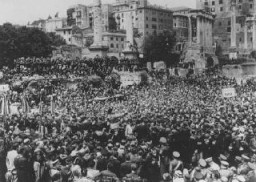
-
